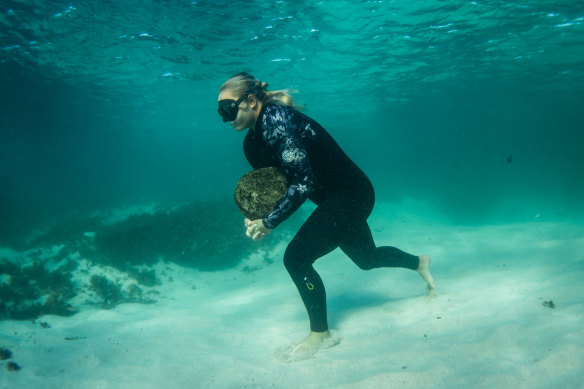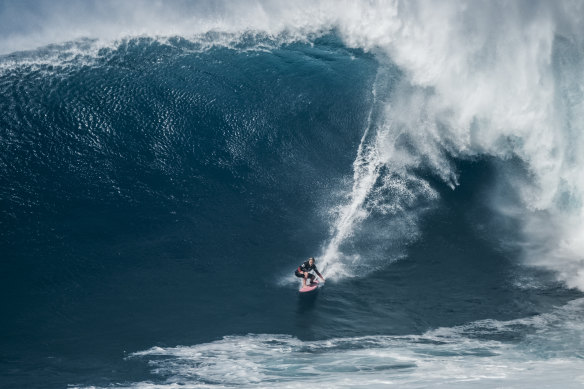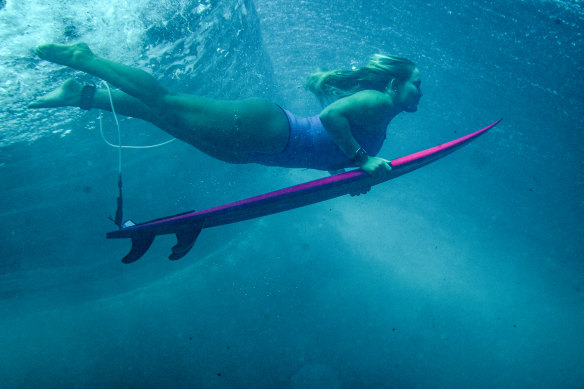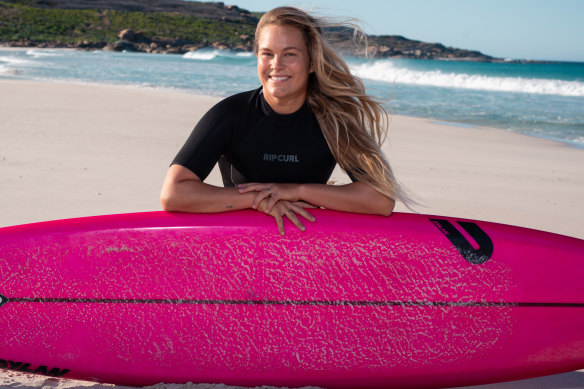By Dan Walsh
Just like the 10-metre waves Felicity Palmateer rides, her training as one of the world’s best big-wave surfers comes with a strict warning.
Do not try this at home.
“My trainer has warned me not to talk about it too much in depth because if you don’t do it properly it can get really dangerous,” Palmateer says.
“We’re talking shallow-water blackouts and it can develop into a life-threatening situation really quickly, so I’m wary of giving people ideas where they can hurt themselves.”
Palmateer, 31, has made both a career and a day-to-day life out of navigating exactly that.
In the past eight years she has: held the record for largest wave ridden by an Australian woman, finished second in 10-12 metre waves at Jaws Maui’s infamous deep-water reef break in the 2019 Big Wave Championships and had the best seat in the house for good friend Laura Enever’s world-record 44-foot (13.3-metre) ride in January.

Felicity Palmateer prepares for Hawaii’s big wave season and the Eddie Aikau Invitational.Credit: Lauren Trickett
It was Palmateer who encouraged Enever to join her at Oahu’s outer-reef “Himalayas” break that day because neither of them would be surfing in the Eddie Aikau Big Wave Invitational, the sport’s most prestigious and exclusive event.
Footage shows Palmateer and her hot pink board right next to Enever as the pair paddled for the same record-breaking wave, before Enever claims right of way.
Now, Palmateer and Enever sit on the cusp of big-wave history yet again as Australia’s first-ever female invitees to ‘The Eddie’ to be held at Waimea Bay, which requires 40ft waves and, as such, has only run 10 times since 1984.
“Oh, I cried when the invite landed in my inbox,” Palmateer says.

Felicity Palmateer on a monster at Jaws in Hawaii during the 2019 Big Wave Challenge.Credit: Keoki Saguibo
“In surfing there’s just no greater honour. It’s the most prestigious big wave event in the world and it holds so much significance in Hawaiian culture.
“Women have only been invited to this year’s event [for the first time in January, which was famously won by local lifeguard Luke Shepardson who surfed 50-foot peaks either side of his shift at a wave-swept Waimea Bay] and only the best of the best are invited. To see my name alongside Kelly Slater is pretty surreal.
“Laura and I had a pretty cool moment together during the [opening] ceremony.
“The whole thing is a ‘pinch me’ moment, we’re both aware that this is the highest honour in surfing and to be recognised on a global stage, it’s a dream come true.”
‘The Eddie’ - the story of the Eddie Aikau Invitational
- The “Super Bowl of surfing” is held at Waimea Bay, only when the wave faces measure 40 feet (12.19 metres) or larger, in memory of legendary Hawaiian waterman Eddie Aikau
- Aikau was the first lifeguard employed on Hawaii’s North Shore, saving more than 500 people and regularly braving the island’s biggest swells
- Aikau disappeared at sea in 1978 while re-enacting the Polysnesian migration voyage between Hawaii and Tahiti in a traditional canoe. Aikau paddled for the island of Lanai on a surfboard when the canoe capsized, and while the rest of the crew was rescued by the coastguard, Aikau was never seen again
- “The Eddie” has run only 10 times since its inception in 1984 and does not allow jet-skis, requiring surfers to paddle into massive Hawaiian waves
With a three-month window for the right swell and conditions in an already heaving El Nino-impacted season, it’s the culmination of endless training and preparation for Palmateer too.
The Margaret River native has spent a lifetime in the water, one that started by being cajoled into “10-foot surf at 10 years old” by her father and well-known ceramic artist Warrick.
For several years now, Palmateer has done her most important training beneath the waves, focusing on Co2 tolerance training that can mean the difference between life and death if a 10-metre wave goes wrong.
“It’s all well and good to do static breath holds and say, ‘Yeah, I can hold my breath for four minutes’, but that’s not relatable to big wave surfing,” she explains.
“There’s nothing relaxing about it, there’s no nice, calm setting. It’s violent. It’s disorientating. Your heart rate is going through the roof. So with the training, you’re trying to regulate your heart rate as quickly as possible, bringing your nervous system down.
“It feels like you’re running at 10-speed on a treadmill at a maximum incline while holding your breath.
“So it’s hard. It’s as much stress as you can manufacture, underwater. But it’s always with someone, never alone.”
Which is why Palmateer is reluctant to go too far into detail.

Felicity Palmateer puts in the hours for a Hawaiian winter at home in Margarets River.Credit: Lauren Trickett
Rush off and start doing a series of exercises underwater without the right training or guidance, and a shallow-water blackout – losing consciousness due to hypoxia – becomes all too real.
But for Palmateer, it’s invaluable when a wall of water comes bearing down. Or, like in 2019 during the last big wave event at Jaws, the valve in her inflatable vest doesn’t work, and the vest doesn’t inflate.
“I’m up in the 4 or 5ams and I’ll have an hour or so of stretching, mobility, functional breathing and visualisation most days,” Palmateer says.
“If the waves are big, that takes priority and I’m surfing all day and I’m always trying to keep the wax under my feet.

Felicity Palmateer and her favourite, hot-pink big wave gun.Credit: Lauren Trickett
“I do a lot of breath-enhancement training, strength and conditioning and running.
“And twice a week I’ll do a [workout] underwater, really high intensity stuff.
“Sometimes I’m in a pool with dumbbells and I might be down there crawling across the bottom of a pool with dumbbells and pulling myself along.
“Or if I’m in the ocean I’m doing plenty of different things with rocks.
“It’s hard stuff and very intense, but I’m wary of giving people ideas where they could hurt themselves.”
Sports news, results and expert commentary. Sign up for our Sport newsletter.